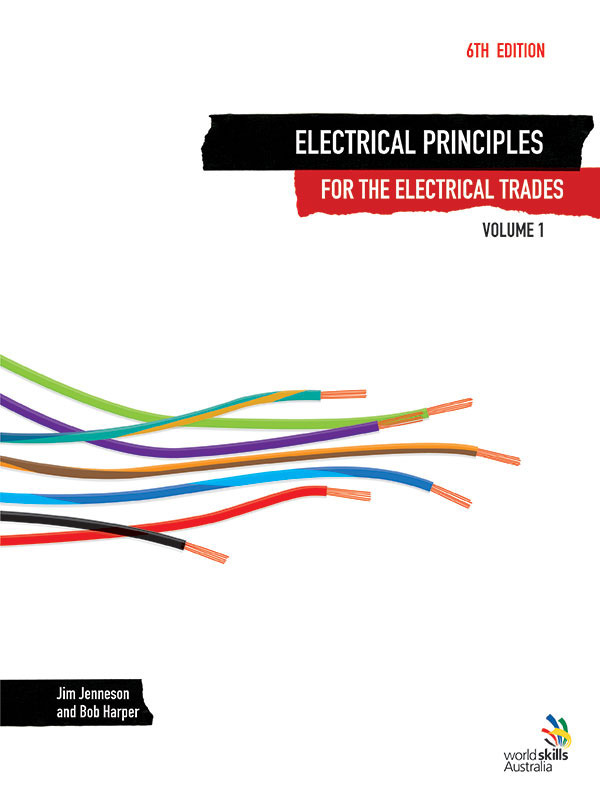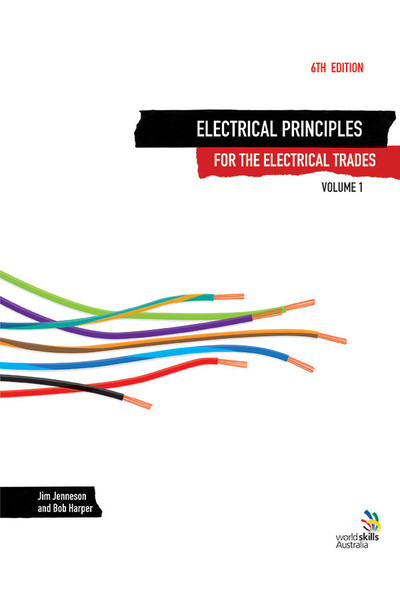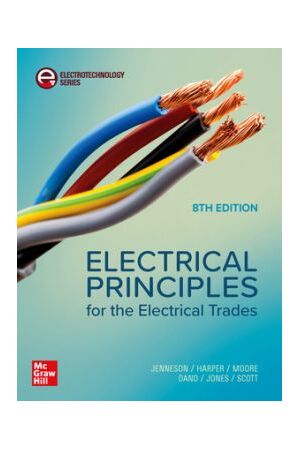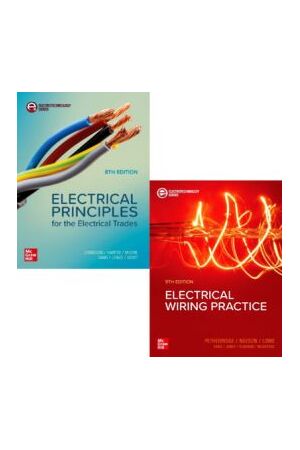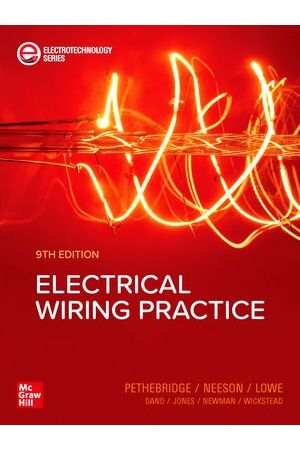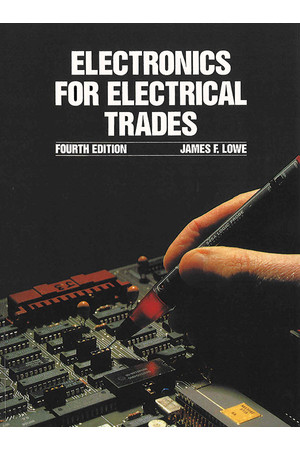Electrical Principles for the Electrical Trades 6th Edition - Volume 1: Blended Learning Package
Rated 2/5 based on 1 reviews.Part of the series Electrical Principles for the Electrical Trades 6th Edition.
View all products in this series
Electrical Principles for the Electrical Trades is now enhanced with McGraw-Hill Education's unique Connect and Connect Plus to provide a complete blended learning solution for Electrical students. This volume presents knowledge and skills specified in units of competency in national training packages for an electrical trade qualification and advanced trade competencies.
Taking on a more practical approach, Electrical Principles for the Electrical Trades now provides students with a range of additional online materials that goes beyond the one-dimensional user experience. This volume is an ideal learning resource for students and trade professionals willing to keep abreast of new developments in Electrotechnology.
Electrical Principles for the Electrical Trades 6th Edition provides a logical learning pathway for Certificate II and III in Electrotechnology in the UEE11 Electrotechnology Training Package. These two volumes are the ideal resource for apprentice and non-apprentice trainees as well as practising tradespeople. This text provides students with the fundamental knowledge needed for a career in the electrical trades.
Presented in two volumes, Volume 1 covers electrical principles and Volume 2 covers electrical machines. The combination of a clear, simple writing style with full-colour diagrams and photographs make these accessible and engaing to all students and professionals.
Features
- Blended learning and teaching options
- Concise full-colour diagrams and photographs illustrate key concepts
- Appropriate language level for student demographic
- Coverage of Cert II and Cert III Electrotechnology courses mapped to the competencies
- Video animations ensure students can easily engage with examples and readings
- Worksheets, interactive quizzes and testbanks maximise student understanding
- Extensive end-of-chapter summaries and review questions ensure retention of presented theory
- Revised and updated to incorporate relevant competencies in UEE07 Electrotechnology Training Package
- Attractive and engaging new four-colour design
- A wealth of diagrams, photographs, graphs and figures to clearly illustrate key concepts
- Student-friendly writing style demonstrates the logical flow from simple to complex theories
- Revised and updated exercises and examples allow students to assess their understanding of the material
- Appendix material expands on key concepts and creates an authoritative and up-to-date text perfect for VET students and as a reference for trades professionals
- Ideal companion text to Electrical Wiring Practice 7th Edition Volume 1 & Volume 2
Contents
Volume 1
- 1 ELEMENTARY ELECTRICITY
- 1.1 Introduction
- 1.2 Natural electricity
- 1.3 The structure of matter
- 1.4 Static electricity
- 1.5 Dynamic electricity
- 1.6 Potential difference
- 1.7 Electrical materials
- 1.8 Measuring electricity – units
- 1.9 Ohm’s Law
- 1.10 Electrical power and energy
- 1.11 Electrical components
- 1.12 Effects of electricity
- 1.13 Electricity and heat
- 2 ELECTROCHEMISTRY
- 2.1 Introduction
- 2.2 Electrochemical energy sources
- 2.3 Voltaic cells
- 2.4 Electrochemical manufacturing processes
- 2.5 Faraday’s laws
- 2.6 Electrolytic corrosion
- 3 MAGNETISM
- 3.1 Magnetism
- 3.2 Natural magnets
- 3.3 Magnetic characteristics
- 3.4 Electromagnetism
- 3.5 Magnetic units
- 3.6 Magnetisation curves
- 3.7 Magnetic hysteresis
- 3.8 Electromagnetic relay switches
- 4 DC CIRCUITS
- 4.1 Parts of electric circuits
- 4.2 Circuit types
- 4.3 Simple circuit analysis
- 4.4 Series circuit analysis
- 4.5 Parallel circuit analysis
- 4.6 Compound circuit analysis
- 4.7 Circuit analysis
- 5 RESISTORS
- 5.1 Factors affecting resistance
- 5.2 Effects of conductor resistance
- 5.3 Resistor types
- 5.4 Non-linear resistors
- 6 INDUCTORS
- 6.1 Inductors
- 6.2 Generation of an EMF in a magnetic field
- 6.3 Lenz’s Law
- 6.4 Inductance
- 6.5 Inductors in direct current
- 6.6 Inductor types
- 6.7 Applications of inductors
- 6.8 Inductor faults
- 6.9 Testing inductors
- 7 CAPACITORS
- 7.1 Introduction
- 7.2 Capacitance
- 7.3 Capacitors in direct current
- 7.4 Capacitor types
- 7.5 Capacitor faults
- 7.6 Testing capacitors
- 8 SINGLE-PHASE ALTERNATING CURRENT
- 8.1 Introduction
- 8.2 Alternating current generation
- 8.3 Alternators
- 8.4 Parameters that affect the generated EMF
- 8.5 Iron losses in ac generators
- 8.6 Generating sinusoidal waveforms
- 8.7 Voltage and current cycles
- 8.8 Construction of sinusoidal curves
- 8.9 Sinusoidal wave values
- 8.10 Phasors
- 8.11 Harmonics
- 9 ALTERNATING CURRENT CIRCUITS
- 9.1 Introduction
- 9.2 Resistance in ac circuits
- 9.3 Inductance in ac circuits
- 9.4 Capacitors in ac circuits
- 9.5 Series R–L–C circuits on ac current
- 9.6 Parallel R–L–C circuits on ac current
- 9.7 Power in ac circuits
- 9.8 Resonance
- 10 THREE-PHASE ALTERNATING CURRENT
- 10.1 Efficiency in generation and distribution
- 10.2 Power efficiency and number of phases
- 10.3 Two-phase systems
- 10.4 Three-phase systems
- 10.5 Three-phase sine-wave construction
- 10.6 Three-phase connections
- 10.7 Power transmission
- 10.8 Three-phase power
- 10.9 Methods of three-phase power measurement
- 10.10 Volt-Ampere Reactive (VAR) measurement
- 11 CELLS AND BATTERIES
- 11.1 Cell and battery construction
- 11.2 Cell and battery parameters
- 11.3 Safety precautions
- 11.4 Battery maintenance
- 11.5 Primary cells and batteries
- 11.6 Secondary cells and batteries
- 11.7 Fuel cells
- 11.8 Solar, standby power supplies and UPS
- AUXILIARY CHAPTER: TOOLS AND RESOURCES
- T&R.1 Mathematics, numbers and units
- T&R.2 SI units (Système Internationale d’Unités)
- T&R.2.1 Base units
- T&R.3 SI derived units
- T&R.4 Transposition
- T&R.5 Energy, work and power
- T&R.6 Scalar and vector quantities
- T&R.7 Trigonometry
View Sample Chapters
Also Available
Electrical Wiring Practice
Electrical Wiring Practice presents the knowledge and skills specified in units of competency in national training packages for an electrical trade qualification and advanced trade competencies.
View Electrical Wiring Practice
| ISBN | 9781743075463 |
| Publisher | McGraw-Hill Education |
| Product Type | Student Books, |
| Year Level | VET, |
Many inaccuracies in Chapter 1
28 January 2019The last sentence of section 1.2 can be very confusing to people who know nothing about electricity. What is “a form of energy common in nature”. Does energy move from one place to another? Section 1.3.3 “The elements that are of greatest...are printed in red (in Table 1.1)...might be involved with.” No element in Table 1.1 is printed in red. The electron configuration is given in Figure 1.1, but it is not obvious to deduct from the Table that the configuration for Cu is (2, 8, 8, 10, 1). Section 1.3.4 An atom can become charged by the removal OR the addition of electrons. The last sentence is an enigma. These are a few examples that make that Chapter quite a poor Introduction for this book. I am quite surprised that proof reading reading did not address those issues. I am just starting reading this book and do not imply that it is a bad book. But I am wondering whether new students may not get confused reading this Introduction. Cheers, Christophe
(2)


